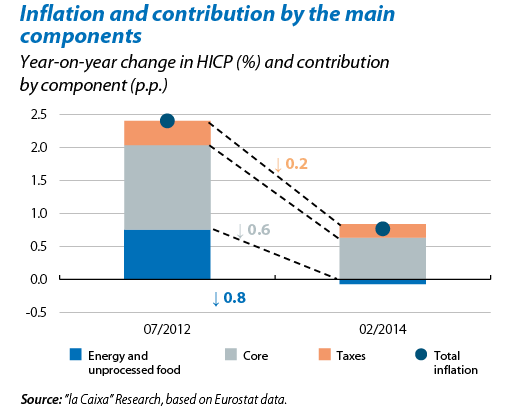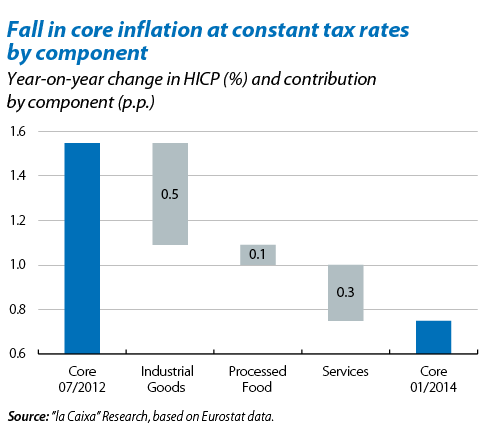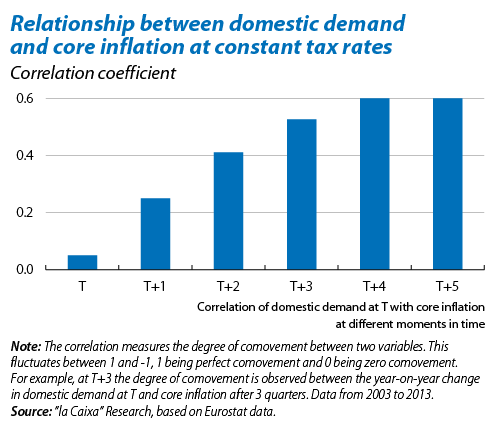
In the first graph we can see that the inflation rate fell by 1.6 p.p. from mid-2012 to January 2014. A drop of this size had not occurred since 2008, when the financial crisis was at its peak. A significant part of this fall is due to factors that can be interpreted as temporary. Energy prices, a factor that is quite volatile but which has traditionally pushed up inflation, have remained relatively stable over the last year and their contribution to the rise in the CPI has therefore diminished considerably. The weakening of the base effect caused by tax hikes in several euro area countries has also helped to bring down the rate of growth in the general price index. What is surprising, however, is the sharp fall in core inflation at constant tax rates as this has historically been more stable and its movements have reflected the underlying trends in economic activity. 40% of the slowdown in inflation is due to the drop in core inflation at constant tax rates.

60% of this contraction in core inflation at constant tax rates can be explained by the fall in the inflation rate for prices of non-energy industrial goods. Together with the price of services, these are a good reflection of the trend in domestic demand. One example of this is that, in periphery countries, where domestic demand has shrunk the most, we can also see a larger reduction in core inflation at constant tax rates. It is important to note, however, that the core inflation rate has historically delayed its reaction to changes in domestic demand. As can be observed in the third graph, the year-on-year change in domestic demand is associated with the core inflation rate seen after a few quarters. We therefore expect core inflation to halt its downward slide over the coming months as the recovery in domestic demand gradually takes hold. However, given that the recovery is not expected to be very vigorous, inflation will probably remain at abnormally low levels for a relatively long period of time. Although the risk of deflation is contained, prolonged low inflation should also make the ECB react.

Recommended Content
Editors’ Picks
EUR/USD extends gains above 1.0700, focus on key US data

EUR/USD meets fresh demand and rises toward 1.0750 in the European session on Thursday. Renewed US Dollar weakness offsets the risk-off market environment, supporting the pair ahead of the key US GDP and PCE inflation data.
USD/JPY keeps pushing higher, eyes 156.00 ahead of US GDP data

USD/JPY keeps breaking into its highest chart territory since June of 1990 early Thursday, recapturing 155.50 for the first time in 34 years as the Japanese Yen remains vulnerable, despite looming intervention risks. The focus shifts to Thursday's US GDP report and the BoJ decision on Friday.
Gold closes below key $2,318 support, US GDP holds the key

Gold price is breathing a sigh of relief early Thursday after testing offers near $2,315 once again. Broad risk-aversion seems to be helping Gold find a floor, as traders refrain from placing any fresh directional bets on the bright metal ahead of the preliminary reading of the US first-quarter GDP due later on Thursday.
Injective price weakness persists despite over 5.9 million INJ tokens burned

Injective price is trading with a bearish bias, stuck in the lower section of the market range. The bearish outlook abounds despite the network's deflationary efforts to pump the price.
US Q1 GDP Preview: Economic growth set to remain firm in, albeit easing from Q4

The United States Gross Domestic Product (GDP) is seen expanding at an annualized rate of 2.5% in Q1. The current resilience of the US economy bolsters the case for a soft landing.